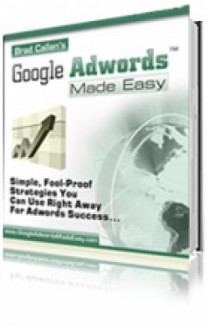
 License Type: Personal Use
License Type: Personal Use  File Size: 2,881 KB
File Size: 2,881 KB File Type: ZIP
File Type: ZIP
 SKU: 24589
SKU: 24589  Shipping: Online Download
Shipping: Online Download
Ebook Sample Content Preview:
Chapter 4 "How to Write Ads that Attract Clicks"
One of the best things you can do to really kick butt with AdWords is to understand that managing your PPC campaign is a step by step process which each step designed to accomplish a specific objective, and with all steps linked, leading your prospect from the start (where they search for the key terms you're bidding on) to the end (where they 'convert' either into buyers or leads orsubscribers).
Note: What I've found is that when I break down AdWords (or keyword research, or SEO, or sales writing basically, any skill) into small steps like this, people instantly find it a lot easier to understand what's going on. I'm hoping that you'll find the same thing with today's chapter on ad writing.
Writing ads, then, is just one step of this process. But before we dive into the specifics, I want to discuss something that is at the heart of any successful Google AdWords campaign:
Focused Keyword Lists.
If you remember from the previous chapter on keyword research, you will remember that it is absolutely critical that you break down your main keyword lists into smaller lists that are focused around subtopics. If your ads are not targeted to your keywords (i.e. a general-purpose ad on insurance showing up for someone who is searching for car insurance) they might not click on your ads. Worse, if your site does not offer a particular type of product (you are targeting custom home theater systems when you don't offer any customisation), all those clicks will be wasted.
And that's the single biggest problem with most AdWords campaigns-a lack offocus. Start off with a basic list, and then expand it into specific subtopic lists as you refine your campaign. One of the ways to do this is the 'Peel and Stick' method (I'll talk about this in more detail in chapter5).
Okthen, on to writing ads.
Ad Writing Basics
Before you write an ad, you have to remember that in even a low-competition market, your ads are under pressure to perform (that is, your clicks must also convert), or otherwise they will end up costing you money. Because of this you should always write ads with two thingsin mind:
The ad must persuade the prospect that the page this ad points to will hold the answer to what they are looking for.
The landing page must deliver on what the ad promises , otherwise the clicks will be wasted (we discuss landing pages in chapter 5).
In addition, you also have to ensure that only those people whom you are targeting will click on your ad. Or to put it differently, you want to make sure that you get the clicks that are most likely to convert into buyers.
Nowthat we knowwhat's required, we can map outsome guidelines forwriting the ad.
Identify what you are selling
Makesureyou have a clearidea ofwhatyou'reselling and howthatwill tiein withyourad. Choose the keywords that apply to yoursite, and include them in your ads.
Narrow down your target market
Understand who you are selling to. An excellent example of this is one of Perry Marshall's recent ads for his book, Guide to Google AdWords. He's targeting serious business-minded people who are willing to pay for quality products, so he's made sure that he lists the product price in the ad. Does that help? It will potentially keep out people who are looking forfree advice or those who cannot afford the book. Narrowing your market.
You can refine the focus of your market by writing down who exactly you are selling to for my weight loss e-book that I wrote way back when I was starting out in Internet Marketing, I focused on young adults who led extremely busy lives and wanted an easy, effective and time-saving solution to managing theirweight problems.
Use focused keywords to help you create a targeted ad
As I've explained in the previous section, focus on subtopics rather than ads for the general keyword they convert much better into customers because you are able to direct them to exactly that page that contains the information they are looking for.
Write to persuade this is sales writing in a very small space
Sales writing boils down to a simple principle convincing the reader to take immediate action on what the writer wants them to do (sign up to a list, buy a product, etc). To do this right, you have to first attract their attention (headline), convey the most powerful benefit (first line) and provide a logical justification for taking that action through your most powerful feature (second line).







